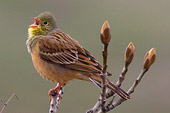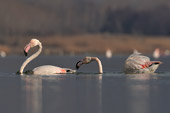Wildlife photography requires not only knowledge, skill, and photographic equipment, but also the suitable accessories to facilitate handling the camera and lens while shooting.
Translated by Cenestelle
This is the first test of a photography accessory, which will be followed by other articles, where I will explain the benefits and shortcomings of various tripods, monopods and other useful photography accessories.
Skimmer Ground Pod is easiest described as essentially a pan-shaped accessory, with a 3/8 adapter installed in the middle, allowing the mounting of a lens or video/photo head directly (pictured below with a Wimberley C12 clamp).
At first glance, it looks almost fragile and brittle, but in reality Ground Pod is made exceptionally sturdy and can easily hold a 600mm lens, and this without a body mounted on the back for balance.
The lower part of SKM-II Skimmer Ground Pod II is constructed from a material that dampens the sound produced by friction against the surface of the ground, and yet, if you drag a heavy lens mounted on the Pod over dry ground, don’t expect miracles – you will soon give yourself away to birds in close proximity to you.
The inner part of the ‘pan’ is ridged, which is very useful, as it allows placing converters, memory cards and other things that you might need while you’re lying down and taking pictures.
Skimmer Ground Pod II is not light – it weighs a whole 425g and it measures 25.5cm in diameter and 3.8cm in height. A Wimberley II head can be mounted on it, but it requires an RB-100 Riser Block.
However, I recommend using it by mounting the lens directly on the Pod, without fully tightening the lens, so that you can freely rotate it left/right, without having to rotate the entire Pod.
There’s an even craftier way to achieve easy and responsive sideways movement for the heavy lens. For this, you’ll have to visit some technomarket, where TV holders are sold – they consist of two plates, attached together, which can be rotated freely in both directions and stand a load greater than even the heaviest telephoto lens, as they are designed for heavy TV sets. This device is light and less than two fingers thick, so it will not raise your viewpoint much, but it will allow you to move the lens very smoothly and you’ll be able to react if there’s some action going on somewhere to the side. You just have to place the holder below Skimmer Ground Pod before you begin to shoot. It has the size of Ground Pod, so they match perfectly.
I also shot a short video, which shows how convenient the pad is to handle, especially if you shoot with a heavy telephoto lens – in this case the combination of lens, camera and the pod itself weighs about 7.5kg, and despite this, the lens can be rotated with a single finger. This is very important when you’re shooting laying down, so that you don’t make unnecessary/ sudden moments trying to rotate the Pod.
I successfully use Skimmer Pod with a Wimberley C-12 Quick Release Clamp attached to it, so that I can quickly release the lens from the Pod when necessary, and also for pure convenience.
Another successful combination is mounting a monopod head, which can allow control over the lens’s up-and-down movement. The lowest and sturdies proven head is Manfrotto 234RC Swivel/Tilt Head, which I’ve been using for years and I’m especially happy with.
Skimmer Ground Pod II is an indispensable accessory when shooting from the lowest possible angle, without depriving yourself of the convenience of freely using both your hands to handle equipment. If you’re laying in the dirt or sand, it protects the equipment and facilitates your movement.
This useful accessory has one significant disadvantage – its $100 price tag! Turns out this plastic pan costs more than my ultra-light carbon monopod and Manfrotto head combined. Well, this probably pretty much explains why I’m the first owner of this accessory in Bulgaria. I believe a price of $50 would sound much more realistic, but this is just me talking.
If you’re not prepared to part with a hundred bucks, you can make one like this yourself, using an old pan. For this, you’ll need a bolt that corresponds to the threading on the telephoto lens handle, insulation material to coat the bottom – thick insulation tape for example – and some dexterity and instruments to turn these things into an accessory that looks like Skimmer Ground Pod II, and most importantly – does the same job.
If you’re not a virtuoso at using the hammer and hack-saw or you’re honestly too lazy to occupy yourself with such silly things, just employ a sturdy Frisbee, which becomes a convenient pad for shooting when turned upside-down. Well, at least it has an advantage – you can play Frisbee with your friends the rest of the time, right?
Shooting from a low angle/ low viewpoint does not always mean that you have to lie on the ground and bend your head. Often times, due to the roughness of the terrain, you may even be sitting and still be level with the bird’s eyes. Not to mention when it’s perched on a plant, tree or another object.
If, however, you’re shooting water birds, the low viewpoint is virtually compulsory. I recently discussed the subject with experienced western photographers and I was deeply impressed by the fact that they take this factor as paramount and shoot most of the time sitting down, where the angle is pretty high, and, in my opinion, deprives the photo of much of its charm.
I’m curious to hear your opinion on the subject. Meanwhile, here are a few photos from a low viewpoint.



















April 28th, 2011 11:10
Ники, ентересна джиджавка. Трите снимки с нея ли са снимани? Иначе смятам да се въоръжа също с такава, но най-вероятно ще е “побългарено” фризби или нещо подобно. Много добре си напипал балканския нерв на бедните балкански фотографи :Р
April 28th, 2011 11:15
да, аз вече само с него снимам от легнало положение. снимката на чайката е с 70-200 – тя е снимана от ръка, понеже обектива е лек и няма проблеми.
точно това аксесоарче няма никакъв проблем да се пригоди и от тиган. виж за други неща няма как да не си платиш скъпото нещо, понеже са трудни за направа, но това е лесно ;)
April 28th, 2011 11:49
Под “други неща” предполагам визираш “неща” като 600/4 л ис усм? :Р
Инак това определено ще се пробва при следващия излет, стига да си довърша гилито дотогава, та да не си личи къде съм се цопнал.
April 28th, 2011 11:55
600/4, 800/5.6 – ей такива неща ;)))
вземи си и въртящята стойка за телевизор, много помага да знаеш. аз не си представям под-а без въртящата стойка от долу.
May 5th, 2011 14:53
Чудя се дали тази тавичка става за макрофотография на ниски растения.
May 5th, 2011 15:00
За макро не вярвам да върши работа, пък и е обемиста и тежка. По-скоро едни малки специални макро триподчета с шейна за по-добро покритие на пространството.
November 5th, 2013 10:13
Поздравления за красивите снимки,които сте направили , истински фотограф е гледайки ги.Интересно с какъв сте направили тези снимки,понеже планувам в скоро време и аз да си закупя някакъв. Страхотно е, че този полезен аксесоар има един съществен недостатък – цената му от 100 USD или по скоро е страхотно че споделихте с нас, за да си направим сметка. Излиза че тази пластмасова тавичка струва по-скъпо от супер лекия карбонов монопод и manfrotto глава взети заедно, както пишете, но пък определено според мен парите си струват, пък и не се харчи всеки ден за такива работи пари.
November 11th, 2013 09:48
Здрасти,
Да, скъп аксесоар е, но е незаменим за снимане от легнало положение. И наистина, веднъж като се купи, остава за цял живот.